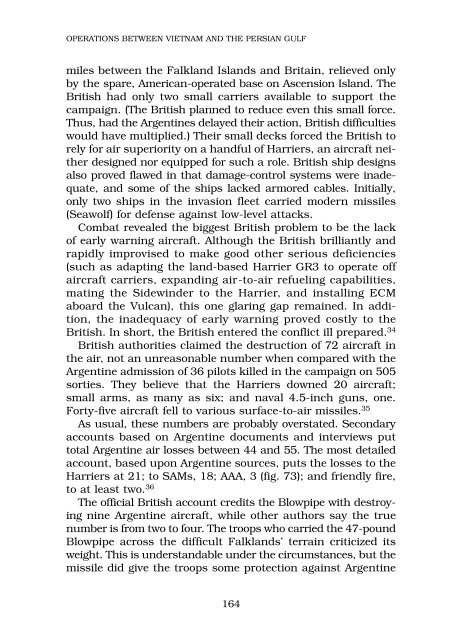Archie to SAM: A Short Operational History of Ground-Based Air ...
Archie to SAM: A Short Operational History of Ground-Based Air ...
Archie to SAM: A Short Operational History of Ground-Based Air ...
Create successful ePaper yourself
Turn your PDF publications into a flip-book with our unique Google optimized e-Paper software.
OPERATIONS BETWEEN VIETNAM AND THE PERSIAN GULF<br />
miles between the Falkland Islands and Britain, relieved only<br />
by the spare, American-operated base on Ascension Island. The<br />
British had only two small carriers available <strong>to</strong> support the<br />
campaign. (The British planned <strong>to</strong> reduce even this small force.<br />
Thus, had the Argentines delayed their action, British difficulties<br />
would have multiplied.) Their small decks forced the British <strong>to</strong><br />
rely for air superiority on a handful <strong>of</strong> Harriers, an aircraft neither<br />
designed nor equipped for such a role. British ship designs<br />
also proved flawed in that damage-control systems were inadequate,<br />
and some <strong>of</strong> the ships lacked armored cables. Initially,<br />
only two ships in the invasion fleet carried modern missiles<br />
(Seawolf) for defense against low-level attacks.<br />
Combat revealed the biggest British problem <strong>to</strong> be the lack<br />
<strong>of</strong> early warning aircraft. Although the British brilliantly and<br />
rapidly improvised <strong>to</strong> make good other serious deficiencies<br />
(such as adapting the land-based Harrier GR3 <strong>to</strong> operate <strong>of</strong>f<br />
aircraft carriers, expanding air-<strong>to</strong>-air refueling capabilities,<br />
mating the Sidewinder <strong>to</strong> the Harrier, and installing ECM<br />
aboard the Vulcan), this one glaring gap remained. In addition,<br />
the inadequacy <strong>of</strong> early warning proved costly <strong>to</strong> the<br />
British. In short, the British entered the conflict ill prepared. 34<br />
British authorities claimed the destruction <strong>of</strong> 72 aircraft in<br />
the air, not an unreasonable number when compared with the<br />
Argentine admission <strong>of</strong> 36 pilots killed in the campaign on 505<br />
sorties. They believe that the Harriers downed 20 aircraft;<br />
small arms, as many as six; and naval 4.5-inch guns, one.<br />
Forty-five aircraft fell <strong>to</strong> various surface-<strong>to</strong>-air missiles. 35<br />
As usual, these numbers are probably overstated. Secondary<br />
accounts based on Argentine documents and interviews put<br />
<strong>to</strong>tal Argentine air losses between 44 and 55. The most detailed<br />
account, based upon Argentine sources, puts the losses <strong>to</strong> the<br />
Harriers at 21; <strong>to</strong> <strong>SAM</strong>s, 18; AAA, 3 (fig. 73); and friendly fire,<br />
<strong>to</strong> at least two. 36<br />
The <strong>of</strong>ficial British account credits the Blowpipe with destroying<br />
nine Argentine aircraft, while other authors say the true<br />
number is from two <strong>to</strong> four. The troops who carried the 47-pound<br />
Blowpipe across the difficult Falklands’ terrain criticized its<br />
weight. This is understandable under the circumstances, but the<br />
missile did give the troops some protection against Argentine<br />
164
















